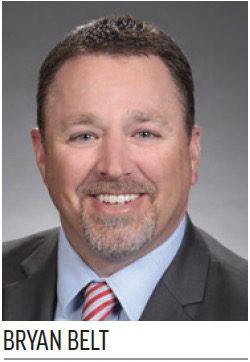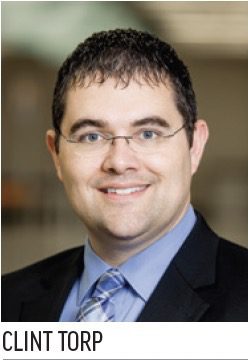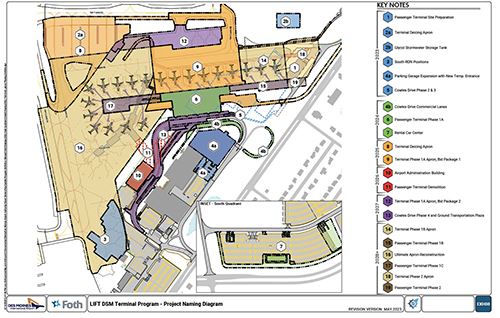The new terminal project at Des Moines International Airport (DSM) is a once-in-a-generation undertaking nearly a decade in the making. But it’s also expected to be an overnight success—that is, in terms of closing the existing terminal one day and starting operations in the new one the next.
The new terminal project at Des Moines International Airport (DSM) is a once-in-a-generation undertaking nearly a decade in the making. But it’s also expected to be an overnight success—that is, in terms of closing the existing terminal one day and starting operations in the new one the next. Most airports that have gone through a major construction project are familiar with this type of transition. But the process DSM is using to ensure everything is ready for opening day isn’t something everyone has heard about.
 ORAT, which stands for Operational Readiness Activation and Transition (or, as it’s sometimes known, Operational Readiness and Airport Transfer), is a process that engages airlines, tenants, airport staff, contractors, concessionaires and other facility users to optimize the operational readiness of a new facility before its doors open. To do so, participants scope requirements, plan and conduct preparation activities toward the end goal, regularly monitoring progress along the way.
ORAT, which stands for Operational Readiness Activation and Transition (or, as it’s sometimes known, Operational Readiness and Airport Transfer), is a process that engages airlines, tenants, airport staff, contractors, concessionaires and other facility users to optimize the operational readiness of a new facility before its doors open. To do so, participants scope requirements, plan and conduct preparation activities toward the end goal, regularly monitoring progress along the way.
Airports that have used ORAT often focus on the “AT” (activation and transition) phases that take place when a new terminal is just about to open. But when the DSM new terminal project got underway in 2021, Executive Director Kevin Foley and his team decided to get help with the “OR” (operational readiness) part, too. Anser Advisory, the owner’s representative for DSM, engaged Chrysalis Global Aviation as its operational readiness sub-consultant in June 2022 for the expected fall 2026 terminal opening.
|
facts&figures Project: Preparing for New Passenger Terminal Location: Des Moines (IA) Int’l Airport
Airport Owner:
Anticipated Terminal Opening: Strategy: Operational Readiness Activation & Transition (ORAT) process
ORAT Consultant: Chrysalis Global Aviation, sub-consultant to DSM owner’s representative
Project Architects/Engineers: Key Participants: Airport staff, airlines, tenants, contractors, concessionaires & other airport users Key Benefits: Optimize operational readiness of the terminal before it opens; solicit & incorporate input about user needs before design is complete |
Rising costs and inflation have delayed the original timetable and led to a multi-phase project without a definitive end date. When complete, the $445 million first phase, known as Phase 1A, will deliver five new common-use gates, a new head house, an expanded central security checkpoint, new baggage handling system, concession areas among other improvements.
The entire terminal project, called Lift DSM, will also include a new rental car center, centralized deicing facility and two expansions adding another 12 gates. The final phase includes demolition of the current terminal. All in, the project is estimated at $769.8 million.
The ROI of ORAT
Sarah Stumpo, senior director for Anser Advisory, engaged Chrysalis just six months into the firm’s contract as owner’s representative. “It’s not every day that airports truly open a new front door,” she says. “It’s not something that can be done within a few weeks. It really does take years of proper planning to make a turnover like that successful.”
And when you’ve invested blood, sweat and tears—not to mention money—in such a project, why not invest in getting it done right?
“You can have the most beautiful airport in the world, but if the baggage system doesn’t work and people don’t know where they’re supposed to stand, it’s a disaster,” explains Suzanne Phelps, managing partner at Chrysalis Global Aviation.
 Andrew Young, director at the firm, says that ORAT doesn’t just save headaches, it saves time and money, too. The double and triple checks that are part of the process mean fewer change orders and fewer renovations required after the airport opens, he explains.
Andrew Young, director at the firm, says that ORAT doesn’t just save headaches, it saves time and money, too. The double and triple checks that are part of the process mean fewer change orders and fewer renovations required after the airport opens, he explains.
Foley says the airport decided to incorporate ORAT into its terminal project very early because DSM is staffed very lean. “We knew that meetings with our tenants were going to be frequent and ongoing,” he says. “That was one of the services Chrysalis provided, so we made them part of our owner’s representative team and let them function as an extension of our staff.”
 Phelps says that using ORAT in the early design stages is common in Europe, but it’s a newer concept in the United States. “Most people think of ORAT as the thing you do right before the building opens. But at that point, you’re not able to make any changes to the design of the facility,” she says. “When you bring in ORAT at the beginning of a project, stakeholders are brought to the table, and they can have input into the actual design of the facility to make sure that it will support the intended operations.”
Phelps says that using ORAT in the early design stages is common in Europe, but it’s a newer concept in the United States. “Most people think of ORAT as the thing you do right before the building opens. But at that point, you’re not able to make any changes to the design of the facility,” she says. “When you bring in ORAT at the beginning of a project, stakeholders are brought to the table, and they can have input into the actual design of the facility to make sure that it will support the intended operations.”
The process takes into account not just the airport’s needs, but the operational effectiveness of the design from the perspective of airlines, TSA, service providers, concessionaires and other tenants as well as contract vendors like janitorial staffing companies.
If the facility isn’t designed correctly for the intended operations, it’s difficult—and expensive—to fix that at the activation stage, Young advises.
He says that airports might be hesitant about the upfront investment that end-to-end ORAT requires, but the return on investment is almost a guarantee when you’re building a facility for 50+ years.

What, Where, Who and How
As conversations with stakeholders began, the team was able to form a picture of “how the building lives and breathes” to help inform the early design, Stumpo explains. “We’re identifying, through our stakeholder assessments, issues the airport is having right now so we can fix those in design to create a better solution for the airport on opening day. That way, we’re not perpetuating the same issues the existing space may have.”
The process starts with identifying everyone involved in or touched by the project and creating working groups—airlines, rental car agencies, safety and security, third-party vendors and service providers. At DSM, that means everyone from Foley and his executive team to the airport’s cable installer gets a say.
The early meetings are informational, providing an overview of the project so stakeholders can start thinking about how it will impact their operations. As the project progresses, the ORAT team solicits more detailed information, such as how much square footage various groups need, what type of workspaces they want, how many rental car transactions occur in a peak hour, whether it makes more sense for bathroom doors to swing in or out, etc.
They also get into the nitty gritty of how everyone moves through the building. What do groups need access to? Who takes out the trash? When? What route do they take? That helps determine details such as access privileges and placement of doors and elevators.
Data from the meeting was reported to project designers at HNTB Corp. and BNIM, who discussed, assessed and eventually wove it into modified designs. Designs, in turn, are shared with the working groups, more questions are asked, more data is captured and the circle continues.
The process is designed to ensure that all parties end up with a design that supports their optimal operation, and to give them the opportunity to be heard. Young says it also improves buy-in. “We want stakeholders to understand that we’re looking out for them and that they have a big role to play in this project.”
 Bryan Belt, DSM’s director of Engineering, says that the fact-finding mission is crucial. “We can’t design without data. But when the project isn’t affecting tenants directly that day, they don’t worry about it. Chrysalis has been great at always keeping in front of them, making sure we have the data in a timely manner, so we can be making those decisions during design.”
Bryan Belt, DSM’s director of Engineering, says that the fact-finding mission is crucial. “We can’t design without data. But when the project isn’t affecting tenants directly that day, they don’t worry about it. Chrysalis has been great at always keeping in front of them, making sure we have the data in a timely manner, so we can be making those decisions during design.”
It’s a lot of questions. And although there aren’t always immediate answers, every bit of information has value—often for problem solving and budgeting. For example, if an airline’s new break room will be the same square footage but the configuration will be different, the carrier may need to budget for new lockers in 18 months; or perhaps the space can be redesigned to allow the airline to reuse its lockers.
Looking Ahead
Multiple rounds of stakeholder meetings capture the current situation and help groups think through future growth plans, too. If TSA shifts to 100% employee screening, what does that look like? If DSM decides to add self-service bag drop in three years, how do we plan for that now? When the car rental agencies start adding more electric vehicles, how many charging stations will they need? Where? When?
“That future planning requires a bit of soul searching,” says John Buckner, Anser Advisory vice president. “You don’t want to overbuild or underbuild. The tenants and airlines know that a market like Des Moines is growing and going to continue to grow, and they want to be prepared for that.”
Building a new facility and promptly having to modify is a bit of a pet peeve for Young. “Of course, there’s a cost implication,” he says. “But the operational side of things gets impacted as well. For example, if TSA does go to 100% employee screening, we’re trying to make sure the facility is still well-designed to support those needs.”
One area that could be affected by that potential future change is the loading dock where external vendors such as UPS and FedEx come in, and trash goes out. Through the ORAT process, it was identified in an early design stage that the plan lacked a convenient elevator for the level of access required. Architects consequently moved one of the elevators that was going to be in a sterile area to a location where it could be used by outside service people and non-badged airline employees. To keep the change within budget, they moved another elevator but kept its shaft in place. That way, the infrastructure is already there if future growth requires another elevator. “If DSM had opened and determined they needed that elevator, that would have been a lot more expensive,” Young explains. “Plus, the employees would have suffered while they were working on getting that up and going.”
Another example popped up during discussions with the airlines about bridges that were going to lose function while the new terminal is under construction. As a result, the team devised a plan to relocate those bridges and add an additional bridge to keep aircraft flying and meet the airlines’ turn requirements.
By analyzing who needed to go where and why, the ORAT process also helped identify access points on the security plans that could be removed because they were not operationally required. That not only saved costs, but also made the terminal more efficient and secure.
In a similar vein, keying all doors that airline employees might need to use was considered through three lenses: access control, the airport security plan and tenant needs. Setting up proper access levels now means nothing should have to be retrofitted after opening.

Avoiding Other Airports’ Mistakes
Phelps points out that most airport professionals will only go through one major facility project—if any—during their career, so they won’t necessarily know what issues might come up or what questions to ask.
Buckner knows that all too well. Before joining Anser Advisory, he served as commercial manager and then as director of Administration and Commercial Services for Salt Lake City International Airport (SLC) for two decades, including during the design and construction of its new terminal that opened in 2020. In that case, the airport contracted Chrysalis later in the process. “We didn’t get the same benefit that I believe Des Moines will realize,” Buckner says. “We just didn’t realize that we were going to need ORAT [that early]. Once we did realize it, a lot of the cake was baked.”
In retrospect, he feels that the broad institutional knowledge Chrysalis brings to the planning and design process minimizes the risk of being surprised or forgetting something. “There’s a lot of benefit from having somebody tell you not to make a mistake that someone else has made,” Buckner notes.
 DSM Operations Director Clint Torp, for one, is grateful for that advice: “Chrysalis has seen what issues have come up at other airports and what solutions worked. They bring that visibility for us to be able to make good sound decisions before we spend the money on a solution or get into the day of operation.”
DSM Operations Director Clint Torp, for one, is grateful for that advice: “Chrysalis has seen what issues have come up at other airports and what solutions worked. They bring that visibility for us to be able to make good sound decisions before we spend the money on a solution or get into the day of operation.”
At the executive level, Foley appreciates that ORAT specialists work several months ahead to help make the project proceed more smoothly. “They may be thinking about where electrical plugins go when we’re still trying to define the amount of space,” he says.
Thanks to the firm’s experience, Chrysalis can also help identify the right contacts to consult when making key operational decisions. Although airport personnel are used to talking with their stakeholders, many higher-level operational decisions require additional expertise from airlines and rental care operators, Torp explains.

Keeping team members apprised of evolving plans has been crucial.
“Chrysalis has already developed a lot of those contact lists and relationships so they can get us to the right people with the first conversation instead of later,” he elaborates.
Upfront Investment in Communication
The ORAT process wouldn’t be possible without constant communication among various project partners. There are weekly and biweekly calls to discuss ongoing projects and identify information that is still needed. Items awaiting answers or input get added to an “issues log.”
Belt, DSM’s Engineering director, says that the collaboration and back and forth communication has been essential—but not always easy. “Sometimes there are ruffled feathers, but what’s great about the whole team,” he reflects. “A feather might get ruffled in the meeting, but everybody is working at a high level, so we move on to tackle the next issue.”
Buckner agrees, “The only way you get a good result is to have very frequent, very regular communications, even if they’re uncomfortable. Time is not your friend when you’re building things.”
Naturally, all of this upfront planning requires the attention of airport staff. “We save time in the long run, but it’s important for airports to understand that there’s a time component internally using the process,” Torp advises.
Chrysalis works to decrease that inevitable time commitment by handling the majority of stakeholder engagement for airport staff. “When we get into large meetings with our tenants, Chrysalis brings that background upfront,” Foley says. “We have a tremendous amount of time saved in those big group meetings because they’ve already done the legwork.”

Activation and Transition
Long before the new terminal is fully operational and certified for occupancy, activation and transition planning will begin.
When the plan is at about 60% design phase, the airport will receive a move assessment and estimated costs so leaders can make decisions about how they want to phase the transition and handle the logistics of the physical move. Another part of the ORAT process is to develop training and operating standards to help ease the transition from the existing terminal into the new one. That type of guidance will help ensure employees know how to get where they need to go and how to use and maintain their new equipment and technology.
In the meantime, a printed newsletter distributed to all airport employees is providing updates and visuals of what’s to come. Stumpo, from Anser Advisory, explains that the newsletter and other communications show staff that DSM is creating a great work environment for them—an important message at a time when employee retention is a hot topic throughout the industry.
“Hopefully, the employees are not only getting excited about having a new space, but they’re seeing the investment in the back-of-house employee spaces,” she says, “and also what this project will mean for the community, which will instill a sense of pride.”



